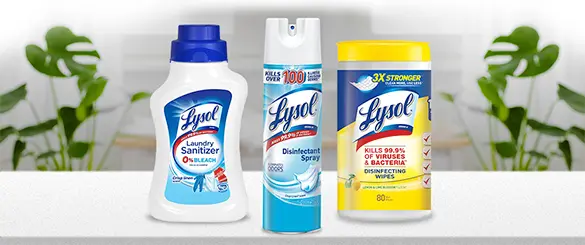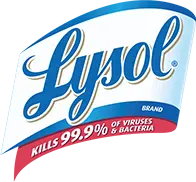Prevent Germs From Spreading
Prevent the Spread of Germs with Surface Cleaning Smarts
In this activity, students will explore the concept of cross-contamination and how germs are passed via hand-to-surface contact. They will identify the “germy” spots in the classroom, research other areas of the school, and develop strategies for helping to prevent the spread of germs at school.

Goals and Skills
STUDENTS WILL:
- Explain how germs can be transferred from hands to surfaces and back to hands/between hands and surfaces
- Identify key “germy spots” in the classroom and develop strategies to prevent the spread of germs
SUPPLIES AND PREPARATION:
- Whiteboard or chart paper
- Note paper/tablets
- Sticky notes
- Art supplies
Instruction Steps
1. EXPLORATORY QUESTIONS.
Spark a class discussion by asking the following questions.
- Why do we wash our hands? (Prompt for students to mention invisible “germs.”)
- What are germs?
- How do germs get passed from one person to another?
- How could germs on hands end up on the surfaces and inanimate objects around us?
Explain that “cross-contamination” is the spread of germs via contaminated surfaces. For example, when you:
- Touch a dirty pencil sharpener
- Place your sandwich on a cutting board that wasn’t washed after holding raw meat
- Sneeze on your hand, then touch a doorknob, and your friend touches the knob immediately afterward
2. A “GERMY” INVESTIGATION.
Remind students that germs are invisible. Most germs are good, but some are not. Germs that cause illness—like the kind of germs that cause a cold or the flu—can live on surfaces and are easily passed from person to person. Here are some interesting facts to illustrate this:
- Studies have shown that germs can live on surfaces like desktops and doorknobs for 20 minutes to two hours or more! That’s why routine cleaning and disinfection is so important, especially in a shared classroom.
- Some germs can grow and divide every 20 minutes. That means one single bacteria cell can become more than eight million cells in less than 24 hours! (Source: LYSOL® Family Health Series)
Tell students that they will conduct an investigation to discover the “germiest” surfaces in the classroom!
- Begin by making a list, as a class, of surfaces/items they touch most often throughout the day. Have students work in pairs to brainstorm key germy spots. Invite each pair to share; they should identify a germy spot that has not yet been mentioned. Add to the list until everyone has had a chance to share. List surfaces on chart paper or on the board.
- Germ hotspot examples: pencil sharpener, pencils, books, desks, doorknobs, science equipment, art supplies, and faucet handles
- Next, have student volunteers use sticky notes to label each of these spots. (As students explore the room, they may think of additional “hotspots” to add to the chart. Label those, too!) Every time a student touches the item that day, he/she should add a check mark to the sticky note.
- At the end of the day (or the next morning), have students tally the number of times these items were touched. Have them brainstorm the best way to visually share the results, such as on a plotted line graph or pie chart.

3. ASSESS AND REFLECT.
To prompt a reflective discussion, ask students the following questions about the activity:
Q: How could we spread germs by touching these items?
Target Answers: If we have germs on our hands and touch an item, someone else can touch the item and pick up the germs.
Q: If one person who touched an item had unwashed hands, how many others could potentially pick up germs by touching that surface?
Target Answers: Unlimited—the people who touch that surface, the people they touch, and so on.
Q: What other ways might germs be spread?
Target Answers: Through “high-fives,” playing basketball, sharing snacks or drinks, pencils, games, computer keyboards, phones, etc. Have students incorporate these activities into their research and continue capturing data for several days.
Have students work with partners and have each explain one way that germs can be transferred from hands to surfaces and back to hands/between hands and surfaces.
Prompt students to link their findings back to the topic of handwashing by asking: how can we help keep our classroom healthy? Have students create handwashing reminder labels to promote clean surfaces and hands in the classroom. Post the reminders near each item to promote handwashing before touching…to help prevent germy hot spots from thriving! For overall class germ prevention, be sure that your classroom surfaces and objects are being disinfected regularly, too.
4. EXTEND THE LESSON.
Ask: Can We Make Others Aware of this Information? Challenge students to conduct additional research through observation/ survey in other areas in the school. For example, they might work in pairs and station themselves in different spots throughout the school and watch how many people touch the doorknob in the office, the pencil sharpener, or computer in the library during a period of time.
Students can then work as a class to multiply their data/time period by the number of minutes in the school day to come up with an estimate regarding how many people touch each object during the course of a school day. Have them incorporate this additional data into their findings/graphs and post the data around the school to inform others using eye-catching messages, such as: “Did you know that more than 200 people touch this doorknob in one school day?” Invite students to develop memorable
Follow-up Ideas:
- Ask students to brainstorm alternative solutions for keeping these spots germ-free, such as bringing their own manual pencil sharpener to school and having a class “chore chart” for keeping them clean
- Invite the head custodian to visit the classroom and join in the discussions
- Create a variation of the “Hot Potato Germ Exchange” (see Germs: Don’t Pass Them Along!) that illustrates how germs find their way onto surfaces in the classroom, in addition to hands.
5. HOME CONNECTION.
Distribute the Germy Home Spots Chore Chart on the next page and have students begin to complete the “Germy Home Spots” hit lists to take home and share with their parents. Together with parents, students can add to the list and create reminders for at-home germ prevention! handwashing jingles or raps, or an illustrated poster that visually promotes handwashing/germ prevention to share with the whole school community
Download the Surface Smarts Lesson Plan
DISCLAIMER:
Healthy Habits® is Presented by Lysol® in collaboration with NEA and National PTA
SOURCES:
Education Standards: (NHES) Health: 1.5.1, 1.5.3, 2.5.3, 2.5.4, 5.5.1, 5.5.3, 5.5.4, 5.5.5, 5.5.6, 7.5.1, 8.5.2; (CCSS) English Language Arts: W.4-5.3, W.4-5.4, W.4-5.5, W.4-5.8, SL.4-5.1, L.4.6; (NAEA) Visual Arts: VA.K-4.1
For more resources, visit CDC – Be A Germ Stopper Poster https://www.cdc.gov/handwashing/pdf/294906-handwashing-superhero-boy-p.pdf
https://www.cdc.gov/handwashing/pdf/294906-handwashing-superhero-girl-p.pdf
CDC – Healthy Schools Parent Engagement Materials https://www.cdc.gov/healthyschools/parentsforhealthyschools/p4hs.htm
CDC - BAM! Body and Mind https://www.cdc.gov/healthyschools/bam/teachers.htm





